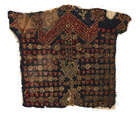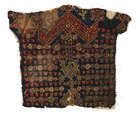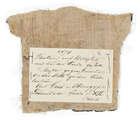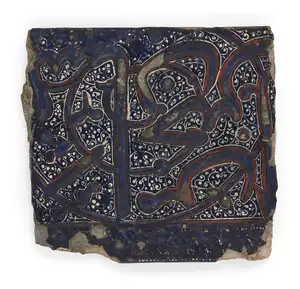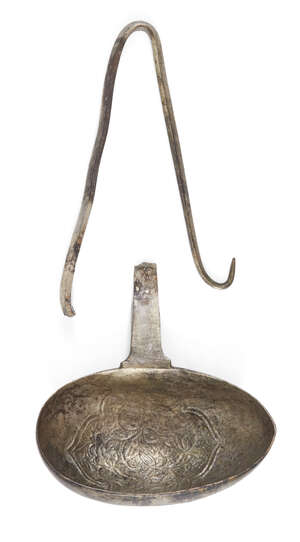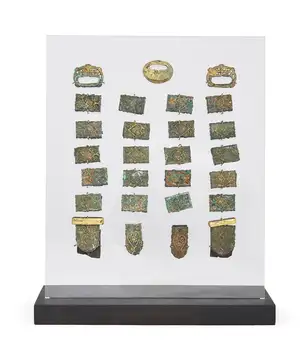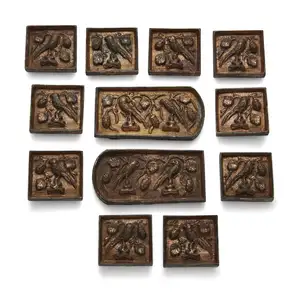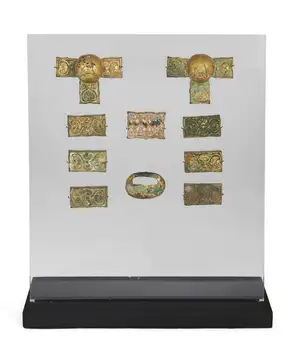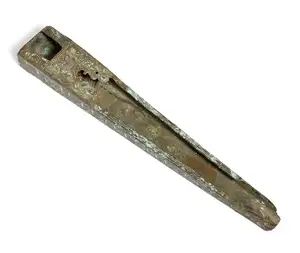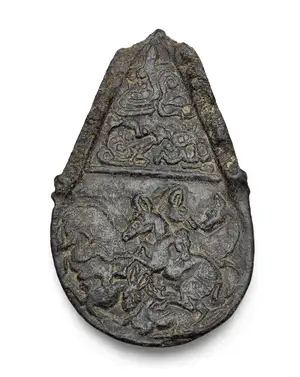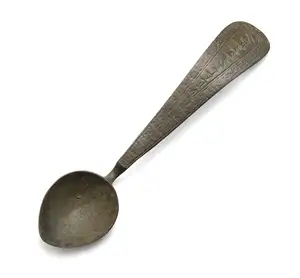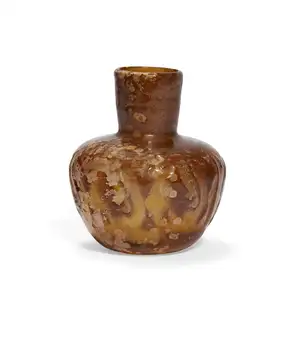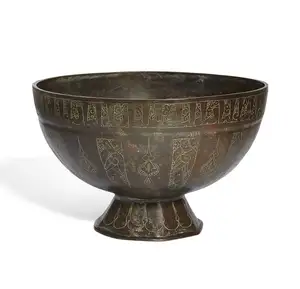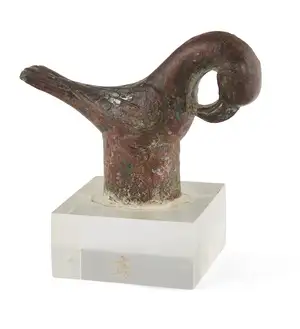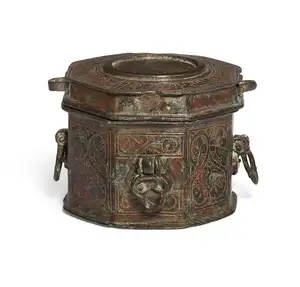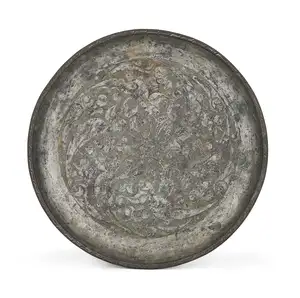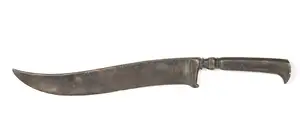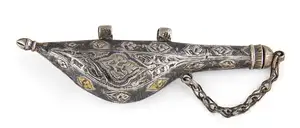Friday 28 April 2023
A Mamluk wool tunic fragment, Egypt or North Africa, 14th century, on a blue linen ground,...
View MoreLot 432
Description
A Mamluk wool tunic fragment, Egypt or North Africa, 14th century, on a blue linen ground, probably the decorative front panel of a tunic, the wool embroidery is in counted thread embroidery of red, light blue and green threads forming geometric and floral motifs arranged horizontally in rows alternating with couched metallic thread embroidery forming roundels and flower-heads, the decoration is further enriched by larger motifs of floral spray to the top, and bold geometric shapes such as the prominent red zigzag shape surmounting the regular rows executed in a combination of both techniques, the couched motifs to the centre may indicate an opening to the tunic, 18.7 cm. long x 22.8cm. wide
Provenance: Leopold Iklé (1838-1922), textile industrialist, connoisseur and explorer of textile works of art
Lot Footnotes
Leopold Iklé was born into a textile family in Hamburg in 1838 and from the age of 15 worked as a travelling salesman for the family firm of Iklé Freres with branches in St Gall, Paris, London, Berlin, Vienna and New York specialising in machine laces. He was always a serious student of historic textiles. Eventually his collection expanded from a box in his office to fill his home in St Gall. In 1904 he gave a substantial donation to the Industrie und Gewerbe Museum in St Gall. After his death in 1922, a major part of his collection was auctioned in Zürich.
An unusual fragment of wool embroidery in coloured threads on a blue linen ground, probably the decorative front panel of a tunic. The wool embroidery is in counted thread embroidery of red, light blue and green threads forming geometric and floral motifs arranged horizontally in rows. alternating with couched metallic thread embroidery forming roundels and flower-heads. The decoration is further enriched by larger motifs of floral spray to the top, and bold geometric shapes such as the prominent red zigzag shape surmounting the regular rows executed in a combination of both techniques. The couched motifs to the centre may indicate an opening to the tunic.
This textile comes from the famous collection of Leopold Iklé (1838-1922), a prominent scholar, student and avid collector of ancient textiles who was born into a textile family in Hamburg. His collection was his only luxury. When people pointed out he ought to buy himself a motorcar in view of his failing health, he said that for the money he would rather buy a few nice pieces of lace. In 1904 Iklé gave a substantial group of textiles from his collection to the Industrie und Gewerbe Musuem in St. Gall.
Leopold's eldest son Fritz (1877-1946) had always taken a great interest in his father's textile collection and helped him choose and organise the pieces. After Leopold's death, Fritz built up his own collection, starting with the part that he inherited in 1922 and purchasing most of the textiles that had passed to his brothers. Fritz became and expert in antique textiles consulted by many museums in Europe. In the 1930s, he conducted extensive research into early textiles. He arranged an exhibition to illustrate this research containing many samples from his collection. His loans to his exhibition were donated to the Museum fur Volkerkunde in Basle.
The dating and identification of this textile begins with the written label note on the reverse (Iklé no. 4478). According to Iklé, the textile was found in an archaeological dig in Egypt and he has catalogued this textile as Fatimid and dates it to the twelfth century. However, Ruth Barnes has noted that the technique suggests a later date than Fatimid and in the collection of the Ashmolean Museum all the counted thread embroideries, the general appearance of the textile suggests a North African provenance. Couching, the other embroidery technique employed on the textile is also common on Mamluk embroideries. These factors combined with the location of its discovery allow us to ascribe a Mamluk provenance to this very unusual embroidery fragment.
Fees & VAT
Buyer's Premium
The buyer shall pay the hammer price together with a premium thereon of 26% up to £20,000 (31.2% inclusive of VAT), 25% from £20,001 - £500,000 (30% inclusive of VAT), 20% from £500,001 thereafter (24% inclusive of VAT). The premium price is subject to VAT at the standard rate.
VAT
VAT is not charged on the hammer price unless it is stated that there is 'VAT applicable on the hammer price at the end of the description. Buyer's premium is subject to VAT.(ARR) - ARTIST'S RESALE RIGHT
Qualifying living artists and the descendants of artists deceased within the last 70 years are entitled to receive a re-sale royalty each time their work is bought through an auction house or art market professional.
It applies to lots with hammer value over £1,000 as follows:
0 to £50,000 - 4%
£50,000.01 to £200,000 - 3%
£200,000.01 to £350,000 - 1%
£350,000.01 to £500,000 - 0.5%
Exceeding £500,000 - 0.25%
ARR is capped at £12,500
Please note ARR is calculated in euros. Auctioneers will apply current exchange rates.
Export of goods
Buyers intending to export goods should ascertain whether an export licence is required before bidding. Export licences are issued by Arts Council England and application forms can be obtained from its Export Licensing Unit. Details can be found on the ACE website www.artscouncil.org.uk or by phoning ACE on 020 7973 5188. The need for import licences varies from country to country and you should acquaint yourself with all relevant local requirements and provisions before bidding. The refusal of any such licences shall not permit the cancelling of any sale nor allow any delay in making full payment for the lot.
Own a similar item?
Request a ValuationReceive alerts about similar lots
Get StartedContinue Browsing
LOT 433
An Ilkhanid Ladjvardinia moulded inscription tile, Persia, late 13th century, of rectangular...
Estimate: £2000 - £3000
LOT 434
An Ilkhanid or Goldon Horde engraved parcel gilt silver spoon, Central Asia or North Iran, 14th...
Estimate: £400 - £600
LOT 435
A group of Ilkhanid gold harness fittings, Iran, 13th century, comprising twenty rectangular...
Estimate: £1500 - £2000
LOT 436
A set of Ilkhanid or Song Dynasty repousse gilt copper belt fittings, Eastern Iran or China,...
Estimate: £3000 - £5000
LOT 437
A group of Ilkhanid or Liao Dynasty gold repousse gilded bronze belt fittings or horse...
Estimate: £2000 - £3000
LOT 438
A Khorassan silver inlaid bronze pencase base, North East Iran, 13th century, of long tapering...
Estimate: £1000 - £1500
LOT 439
A Ghaznavid steatite mould, Persia, 11th century, of drop-shape, carved with a complex design of...
Estimate: £300 - £500
LOT 440
A bronze spoon, possibly Seljuk Persia, 12th century or later, the elliptical bowl with pointed...
Estimate: £600 - £800
LOT 441
A small amber coloured mould-blown glass jar with Kufic pseudo-inscriptions, Central Asia, 12th...
Estimate: £1000 - £1500
LOT 442
An engraved Khorassan footed bowl, Persia, 13th century, on an octagonal foot, with deep bowl,...
Estimate: £1000 - £2000
LOT 443
A silvered bronze figure of a bird, probably a thumbrest, Persia, 12th century, depicted with...
Estimate: £200 - £300
LOT 444
An engraved bronze inkwell, Khorasan, Persia, 12th century, of octagonal form, engraved to lid...
Estimate: £3000 - £4000
LOT 445
An Aq Qoyonlu or Kara Qoyonlu Timurid tinned copper dish, Persia, 15th century, of shallow form...
Estimate: £800 - £1200
LOT 446
A butcher's sharpening tool and chain, Persia or Deccan, 17th/18th century, the chain...
Estimate: £1200 - £1500
LOT 447
A Safavid silvered steel dagger, Persia, 17th century, formed of one sheet of metal, with...
Estimate: £500 - £700
LOT 448
A Safavid gilt-decorated and nielloed silver perfume flask, Persia, 17th century, in the form of...
Estimate: £300 - £500
 Newsletter Signup
Newsletter Signup
 Keyword Alerts
Keyword Alerts
Would you like to receive personalised keyword alerts when new catalogues go live. If so, please indicate these below
Set a password to save your keyword alerts
Passwords are a minimum of 7 characters and must include an upper case letter, a lower case letter, a number and a special character (e.g., !@#$%^&*).


